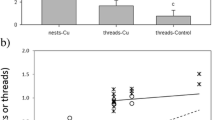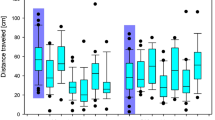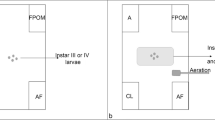Abstract
This study investigated the bioaccumulation and effects of mercury (Hg) in funnel-web spiders, Agelena labyrinthica, following exposure to sublethal concentrations of Hg(NO3)2 in their drinking water. The results showed that the Hg content in adult A. labyrinthica increased rapidly with the number of days exposed to the Hg(NO3)2 solution, and the mortality of adult spiders within 30 days increased with increased concentrations of Hg(NO3)2 in the drinking water. The total developmental duration of A. labyrinthica exposed to Hg(NO3)2 was significantly longer than in the control spiders, but there were no significant differences in the total developmental duration of spiders among the three treatment groups (exposed to 10, 20 and 50 mg/L Hg(NO3)2 solution). We also compared the web-weaving of the control and treated spiders, and found no significant differences in shape, structure, color, or size of the webs between the control and treated spiders; however, there was a significant difference in web placement between the treatment and control groups. The spiders in the control group appeared to have an episodic-like memory, choosing to weave their five webs in the same corner in the five time periods allowed.


Similar content being viewed by others
References
Babczyńska A, Wilczek G, Szulińska E, Franiel I (2011) Quantitative immunodetection of metallothioneins in relation to metals concentration in spiders from variously polluted areas. Ecotox Environ Saf 74:1498–1503
Chen XQ, Zhang ZT, Liu R, Zhang XL, Chen J, Peng Y (2011) Effects of the metals lead and zinc on the growth, development, and reproduction of Pardosa astrigera (Araneae: Lycosidae). Bull Environ Contam Toxicol 86:203–207
Clayton NS, Dickinson A (1998) Episodic-like memory during cache recovery by scrub jays. Nature 395:272–274
Davies NB, Krebs JR, West SA (2012) An introduction to behavioral ecology. Blackwell Science Ltd, West Sussex
Fountain MT, Brown VK, Gange AC, Symondson WOC, Murray PJ (2007) The effects of the insecticide chlorpyrifos on spider and Collembola communities. Pedobiologia 51:147–158
Hayford BL, Ferrington LC (2005) Biological assessment of Cannon Creek, Missouri by use of emerging Chironomidae (Insecta: Diptera). J Kans Entomol Soc 78:89–99
Hendrickx F, Maelfait JP, Speelmans M (2003) Adaptive reproductive variation along a pollution gradient in a wolf spider. Oecologia 134:189–194
Jung MP, Lee JH (2011) Bioaccumulation of heavy metals in the wolf spider, Pardosa astrigera L. Koch (Araneae: Lycosidae). Environ Monit Assess 184:1773–1779
Jung CS, Lee SB, Jung MP, Lee JH, Lee S, Lee SH (2005) Accumulated heavy metal content in wolf spider, Pardosa astrigera (Araneae: Lycosidae), as a bioindicator of exposure. J Asia Pac Entomol 8(2):185–192
Jung MP, Kim ST, Kim H, Lee JH (2008) Species diversity and community structure of ground-dwelling spiders in unpolluted and moderately heavy metal-polluted habitats. Water Air Soil Pollut 195:15–22
Laing GD, Bogaert N, Tack FMG, Verloo MG, Hendrickx F (2002) Heavy metal contents (Cd, Cu, Zn) in spiders (Pirata piraticus) living in intertidal sediments of the river Scheldt estuary (Belgium) as affected by substrate characteristics. Sci Total Environ 289:71–81
Massadeh A, Al-Momani F, Elbetieha A (2008) Assessment of heavy metals concentrations in soil samples from the vicinity of busy roads: influence on Drosophila melanogaster life cycle. Biol Trace Elem Res 122:292–299
Mousavi SK, Primicerio R, Amundsen PA (2003) Diversity and structure of Chironomidae (Diptera) communities along a gradient of heavy metal contamination in a subarctic watercourse. Sci Total Environ 307:93–110
Sepehr B, Hilliker AJ (2009) Biological and behavioral effects of heavy metals in Drosophila melanogaster adults and larvae. J Insect Behav 22:399–411
Shao XL, Peng Y, Hose GC, Chen J, Liu FX (2006) Spider webs as indicators of heavy metal pollution in air. Bull Environ Contam Toxicol 76:271–277
Thornton I (1991) Metal contamination of soils in urban areas. In: Bullock P, Gregory PJ (eds) Soils in the urban environment. Blackwell, Oxford, pp 47–75
van Ooik T, Rantala MJ, Saloniemi I (2007) Diet-mediated effects of heavy metal pollution on growth and immune response in the geometrid moth Epirrita autumnata. Environ Pollut 145:348–354
Wheater CP, Cullen WR, Bell JR (2000) Spider communities as tools in monitoring reclaimed limestone quarry landforms. Landsc Ecol 15:401–406
Wilczek G, Babczyńska A (2000) Heavy metals in the gonads and hepatopancreas of spiders (Araneae) from variously polluted areas. Ecologia (Bratislava) 19:283–292
Wilczek G, Babczyńska A, Migula P, Wencelis B (2003) Activity of esterases as biomarkers of metal exposure in spiders from the metal pollution gradient. Pol J Environ Stud 12:765–771
Wilczek G, Babczyfiska A, Augustyniak M, Migula P (2004) Relations between metals (Zn, Pb, Cd and Cu) and glutathione-dependent detoxifying enzymes in spiders from a heavy metal pollution gradient. Environ Pollut 132:453–461
Zhao JZ (1993) Spiders in the cotton fields in China. Wuhan Publishing House, Wuhan
Acknowledgments
This study was supported by the National Natural Science Fund of China (31071895), the Natural Science Fund of Hubei Province (2011CDB071) and the Key Scientific and Technological Projects of Wuhan (No: 201120722216-3). We are grateful to the anonymous reviewer and the associate editor for their suggestions and improvements to this manuscript. We also thank Dr. Janet W. Reid (Biological consulting and editing services, JWR Associates, New York, USA) for helping us edit the English.
Author information
Authors and Affiliations
Corresponding author
Rights and permissions
About this article
Cite this article
Liu, J., Gao, J., Yun, Y. et al. Bioaccumulation of Mercury and Its Effects on Survival, Development and Web-weaving in the Funnel-Web Spider Agelena labyrinthica (Araneae: Agelenidae). Bull Environ Contam Toxicol 90, 558–562 (2013). https://doi.org/10.1007/s00128-013-0966-y
Received:
Accepted:
Published:
Issue Date:
DOI: https://doi.org/10.1007/s00128-013-0966-y




